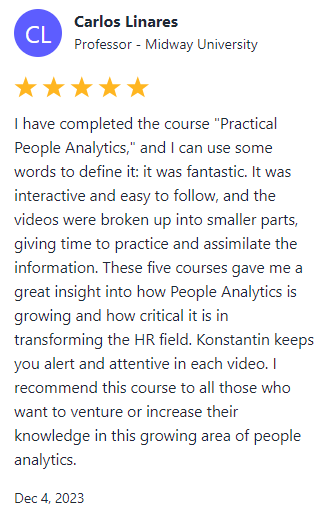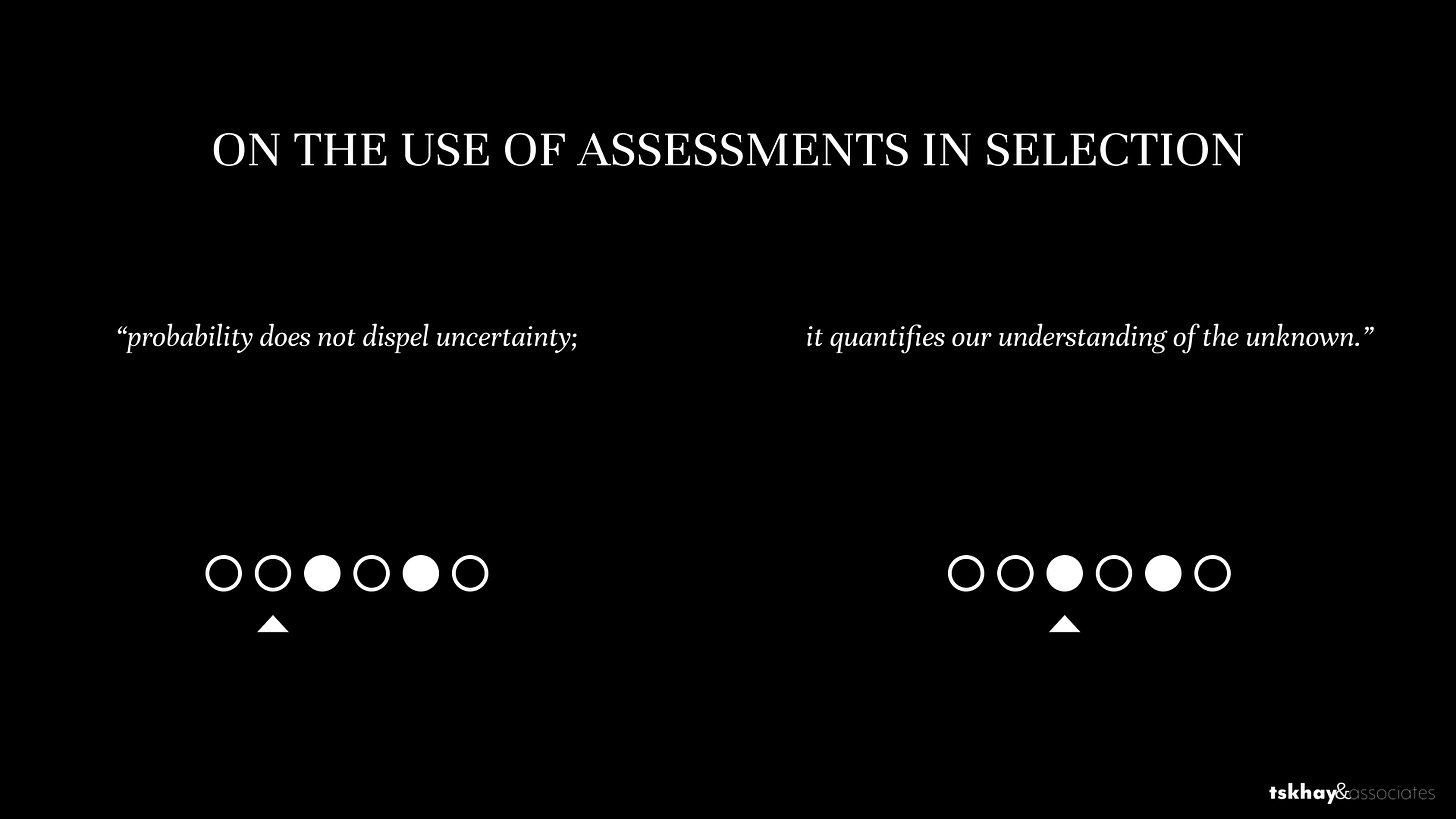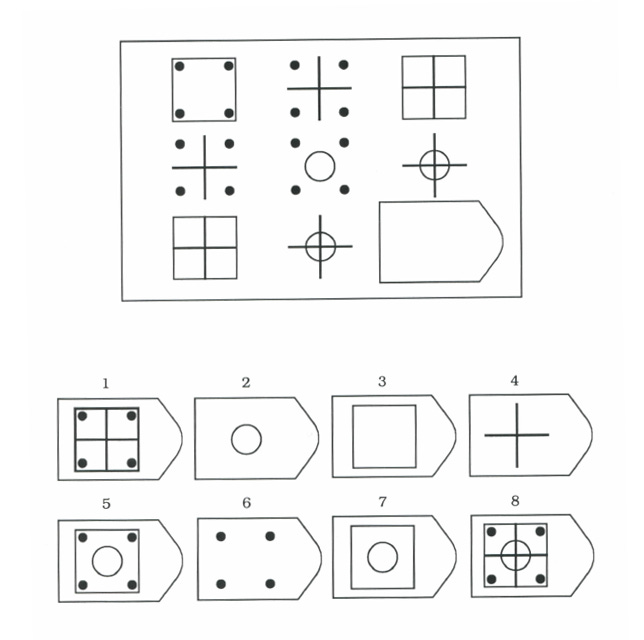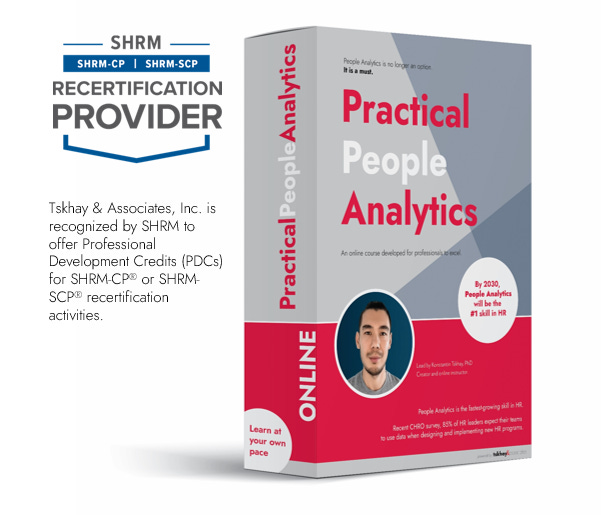Transform the way you assess candidates in just a 10 minutes
And start hiring top talent more efficiently.
Hi, Friends,
I am so delighted by the reception of my Practical People Analytics Course and a new testimonial that is just fantastic:
Also, I have spent the last two days recording a new course:
People Analytics 101: A Blueprint to People Analytics for HR.
I plan to release it to everyone for FREE before the holiday as my year-end gift to the community. I would appreciate it if you could share it once it is out!
Thanks in advance!
Okay, onto the letter.
This week, I want to talk about Selection Assessments:
Why having a single interview guide is better than many
How to design a problem-solving capability assessment
How to create a job proficiency assessment
I focus on selection today because most organizations want to use a scientific approach to select the right talent every time, but very few do it well. Once you understand how to set up your selection assessment, you can follow a similar logic in your organization, designing assessments to hire the right staff.
Let’s dive in!
Big Idea: Assessments reduce uncertainty.
To select great talent consistently, you first need to make sure you don’t make a few of the most common mistakes:
Lack of a Structured Interview System: Effective recruiting hinges on a consistent, structured interview approach. A robust system employs a standardized interview guide, ensuring uniformity in candidate evaluation. The system fails if the guide isn’t used consistently or changes with each job opening. Consistency is key to reliably identifying top talent.
Questioning the Validity of Assessments: The buzz around selection assessments is growing, but the effectiveness of many is questionable. Few assessment providers back their methods with robust validity studies (I am yet to find one). Understanding and ensuring the validity of assessments is crucial, as we'll explore with our problem-solving assessment example.
Mismatch Between Assessments and Job Requirements: General assessments like personality tests will fail to reveal a candidate's job-specific capabilities. For instance, knowing a candidate's extraversion provides no insight into their Excel skills. This highlights the need to develop assessments that are directly linked to the actual requirements of the job, a topic we will delve into further.
People make these mistakes because they don’t understand how assessments work.
As a result, they remain stuck in uncertainty that feels like certainty because they have some semblance of an assessment.
Yet, only a valid assessment can decrease uncertainty.
So, here’s how to fix it:
#1 Build a Simple and Robust Interview Guide
Building a simple interview guide is the first step to making a solid hire.
A simple and repeatable interview guide will structure your candidate conversations and experience and allow you to evaluate all candidates from the same viewpoints.
Everyone knows that a simple and robust interview guide provides:
Consistency in evaluation
Structure for comparison
Alleviation of personal biases
So, why do these guides become long, unruly, convoluted and ineffective?
That’s because we believe a customized interview guide will yield better outcomes for specific roles we are selecting for. And most of all, we believe unique questions will allow us to identify the right candidates quickly.
But it’s not the questions that help us identify if someone is suitable for the job.
It’s the scoring.
In other words, it’s not about how you ask the question about, say, adaptability:
“Tell us about a time you adapted to a significant change at work."
It’s about how you evaluate the answer:
1: Resistant to change.
3: Adapts to change when necessary.
5: Embraces and thrives in changing environments.
So, when developing the guide, focus on making your overall recruitment process simple, quantifiable and repeatable. And to ensure you select the right candidate, focus not on the question but the answer.
#2 Create Assessments that Matter
The next step to making the right selection is to have VALID assessments.
Valid assessments measure what they are supposed to measure.
The common misconception is that any test or assessment is automatically valid just because it exists.
This belief leads to using generic tests without considering their relevance for the specific attributes they are intended to measure.
If you want validity, tailor the assessments to the specific skills, knowledge, or abilities you want to measure. Analyze the job requirements and develop assessments aligned with these requirements.
Let’s take problem-solving as an example.
A generic verbal and mathematical ability test cannot capture the complexity of problem-solving. After all, having a good vocabulary speaks more about your schooling than it does about how quickly you get out of trouble.
You can take the problem-solving assessment to the next level by presenting the candidate with a tool that tests abstract reasoning, like Raven Progressive Matrices. This assessment will tap into how quickly they can cut through complexity. (Tell me what you think the result is here).
You will know they can solve puzzles.
But are those puzzles the same ones they will encounter at work?!
If you want to really test problem-solving, heed the advice of the consulting firms—use illustrative case studies to see how the person thinks, what questions they ask, and which assumptions they make. The test is relevant to their work and will likely provide an accurate and valid view of the candidate.
The key takeaway is that an assessment's validity lies in its ability to accurately measure the specific traits or skills it is intended to evaluate. You can make more informed and effective selection decisions by creating tailored, job-specific assessments. This approach enhances the selection process and improves job performance and satisfaction.
#3 Specific job-proficiency assessments
Speaking of specific!
Finally, implementing specific job proficiency assessments is the last step to achieving accurate and effective employee selection.
Why?
Specific job-proficiency assessments directly evaluate a candidate's ability to perform the tasks they will face in their role. This approach moves beyond general capabilities and focuses on the practical skills and knowledge critical for job success.
A common mistake is relying solely on generic assessments for all positions, such as standard aptitude, problem-solving, or personality tests. This one-size-fits-all approach overlooks the unique aspects of each role.
Develop (or buy) assessments to measure the skills required for the job:
You need Excel; measure Excel.
If you want sales skills; measure sales skills.
You want mechanical skills; measure mechanical skills.
You get the point.
These assessments are based on a thorough job analysis of the tasks in the role. You want to work with the subject matter experts within roles to define each skill and proficiency level and only design a valid test.
For Excel, develop a take-home test, where the candidate gets a dataset they need to analyze while recording their screen and thinking, paired with a panel presentation of the findings. This directly assesses the candidates’ proficiency with the tool and ability to communicate the results.
For a sales position, use a role-play exercise simulating a sales scenario rather than a generic problem-solving test. The candidate must demonstrate their ability to persuade and close a deal, directly assessing their sales proficiency and fit for the role.
The critical takeaway is that you must use assessments tailored to the specific job skills for effective employee selection. By doing so, you can more accurately predict a candidate's job performance and ensure a better fit for the role.
That’s it!
As always, thanks for reading.
Hit reply and let me know what you found most helpful this week—I’d love to hear from you!
See you next Wednesday,
K
Whenever you’re ready, there are 2 ways I can help you:
#1 If you’re still looking to get started in People Analytics, I recommend starting with my affordable course:
Practical People Analytics: Build data-driven HR programs to 10x your professional effectiveness, business impact, and career. This comprehensive course will teach you everything from building an HR dashboard for business results to driving growth through more advanced analytics (i.e., regression). Join your peers today!
#2 If you are looking for support in your human capital programs, such as engagement, retention, and compensation & benefits, and want to take a more data-driven approach, contact me at Tskhay & Associates for consulting services.









